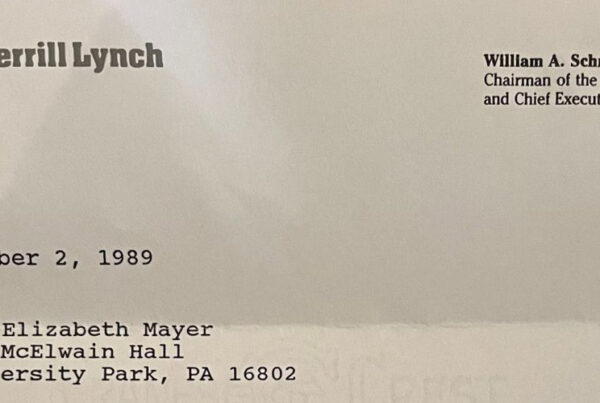
Article Summary: [Part 1 of 2] Has this ever happened to you? You have an excellent working relationship with a key decision maker (let’s call her Susan) at BestClient Organization. Over time, you have built up a strong bond with Susan, based on consistent quality and value. Your strong relationship has guaranteed a contract renewal each year. Then (cue the playing of scary music) a reorganization occurs. Susan departs. BestClient STILL needs you. With Robby now running the department, what are you going to do? Four key steps are outlined in this two-part series to develop new internal champions. Following the steps will help you keep your customers forever.
Keep Your Top Customers Forever: Ensure Long-Term Retention with Internal Champions, Part 1
Copyright © 2009. The Chief Storyteller®, LLC. and ThinkBusiness Magazine
Ira J. Koretsky
May 2009
[This is a two-part article. The second article is, Keep Your Top Customers Forever: Ensure Long-Term Retention with Internal Champions, Part 2]
Has this ever happened to you?
You have an excellent working relationship with a key decision maker (let’s call her Susan) at BestClient Organization. Over time, you have built up a strong bond with Susan, based on consistent quality and value. Your strong relationship has guaranteed a contract renewal each year. Then (cue the playing of scary music) a reorganization occurs. Susan departs. BestClient STILL needs you. With Robby now running the department, what are you going to do? What are the chances of building a relationship with Robby like the one you had with Susan? Most importantly, will Robby readily sign your contract for the coming year?
Significant events outside your control may occur at customer organizations any time. Examples include promotions, change of management, reassignments, mergers, acquisitions, retirements, and departures for a new job. Should a “significant event” occur to your key contact, your business relationship with that organization or department may be in jeopardy. At the very least, you must devote additional effort to build up the relationship to compare to the one you enjoyed with Susan.
A deliberate relationship building plan within your customer’s organization minimizes and can mitigate negative consequences from significant changes. Your success to long-term retention lies in building multiple internal champions who complement your relationship with your key person.
Four key steps are outlined in this two-part series to develop new internal champions. Today, we will cover steps one and two. Part 2 describes steps three and four. Following the steps will help you keep your customers forever.
Step 1: Develop Your Top Customer Profile (TCP)
If you are like many in thousands of organizations today, you more often than not, unknowingly exclude important criteria in evaluating the importance a customer has to your organization. Most organizations use financial metrics like annual revenue, frequency, gross margin, acquisition cost, etc. I suggest adding criteria that is often overlooked. And this criteria is just as important, perhaps more, in growing your organization. Example criteria include value and frequency of referrals, value of testimonials, videos, and past performance (e.g., case studies, use cases, and success stories). Including these criteria provides a more accurate lifetime customer value (LCV). At The Chief Storyteller®, we call this tool your Top Customer Profile (TCP).
Together, let’s walk through the process to create your own TCP. If you have never ranked your customers, spreadsheet software makes this process easy. Here are the walk-through instructions for developing your TCP in Microsoft Excel. Figures follow the instructions.
- Identify five ranking criteria. Note, we are using five here to make this process easier. Please use whatever criteria is important to your organization. Annual revenue, LCV, Engagement Size, Gross Margin, Expected Engagement Longevity, Referrals, Testimonials, YouTube, Past Performance, etc. are all good examples
- Label the spreadsheet columns as follows: A as Customer, B through F with the five criteria identified in Step 1, G as Total, and H as Priority
- Populate column A, Customer, with the names of your customers
- Input your evaluation score for each of the five criteria columns for each customer using a 10-point scale with 10 as the highest score. In general, focus your evaluations on more recent years
- Sum the values in columns B through F into the Total column G
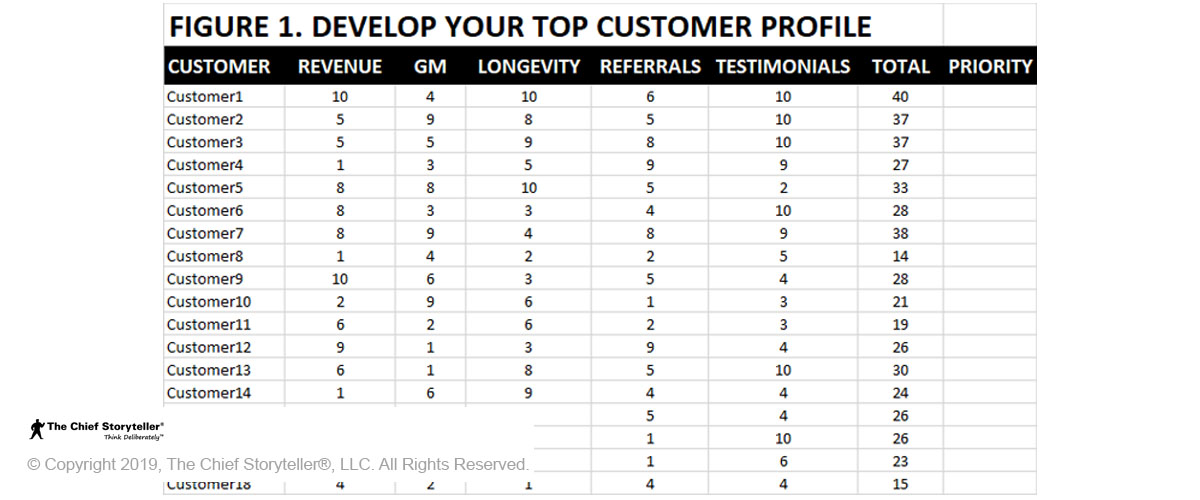
- Sort the table by Total, from highest to lowest (see Figure 2)
- Divide the sorted client list into three segments. Each segment should represent a third of your customers
- Classify the top segment as “1” under Priority, the second segment as “2,” and the bottom segment as “3”
You now have a ranked listing of your customers. As you do more and more TCP and LCV modeling, refine, change, and add to your criteria and segments.
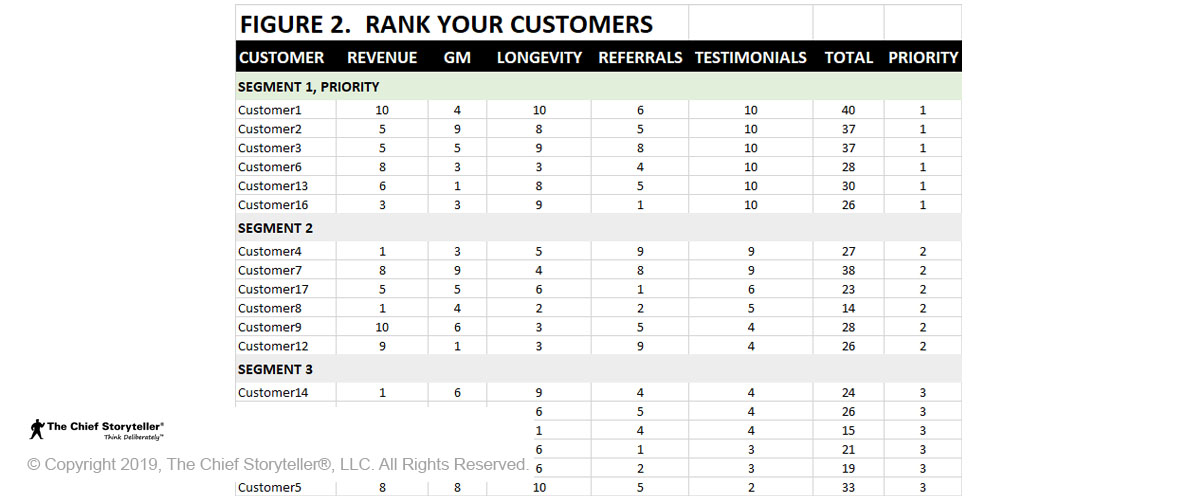
Step 2: Identify New Champions
Let’s concentrate on just the first third, the “Priority” group with a rating of “1,” and call them your top customers. Within your spreadsheet, do the following:
- Add a heading of Champions to Column I (see Figure 3 below)
- In the Champions column, enter the number of people in your customer’s organization with whom you have a very strong relationship AND where each champion has significant status. Significant status includes decision makers, major influencers, opinion leaders, executives, and thought leaders. The “AND” here is very important, as each key person must be in some type of decision-making position
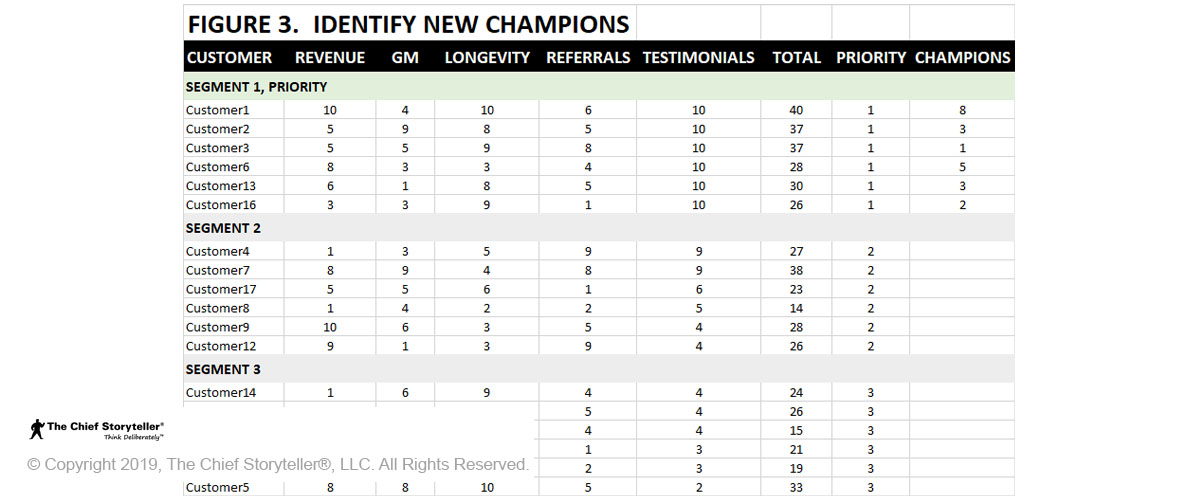
- Sort the top customer segment (the Priority group with a rating of “1”) based on the value in the Champions column, from lowest to highest. The first organization listed is your top customer with the fewest relationships to champions. This is the organization with the greatest downside relationship risk. In Figure 4, you’ll see this as Customer3 in red text color, with just one champion. Now you can visually see what organizations you need to increase your champions.
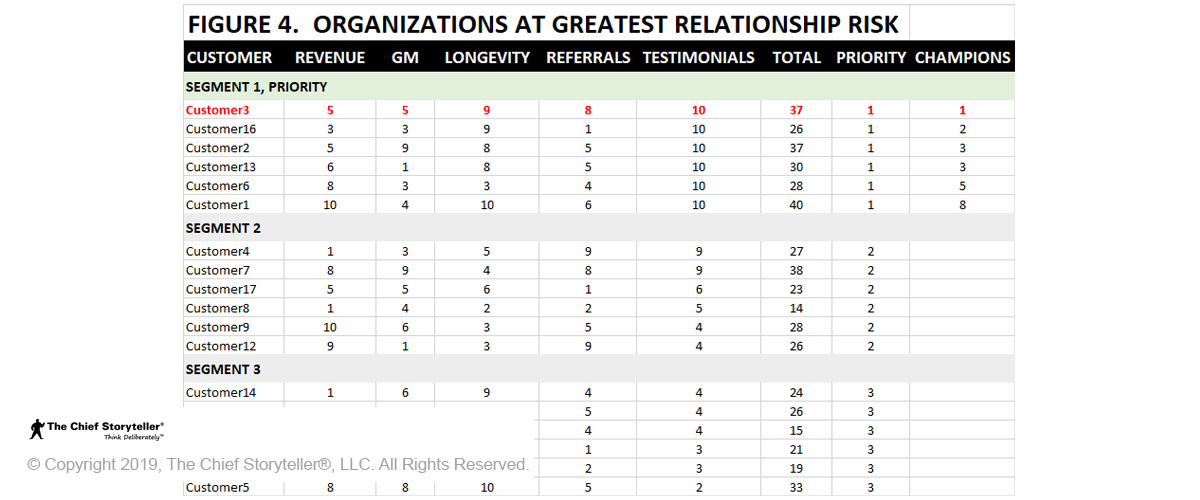
Abracadabra (well, sort of), you have ranked your top customers according to a simplified customer risk analysis. Within the spreadsheet, you can add as many criteria and segments as you would like. Then, perform advanced data analysis to model and refine the list.
This ends part one.
In part two, we will cover Step 3, identifying new key persons to build relationships with over time and Step 4, developing your own plan to turn these new key persons into internal champions. Together, implementing these four steps will ensure your long-term retention with your top clients, no matter what personal, professional, and organizational changes may occur.
Contact us to learn more about better engaging with your stakeholders and target audiences with our communication, marketing, sales, and storytelling keynotes, workshops, coaching, and services.
Read More ThinkBusiness Articles
- When Nobody is Looking, Character Still Counts – Make Your Business Stories Credible (read)
- Shoulda, Woulda, Coulda – 5 Activities You Really Should Do (read)
- Business is Personal – 3 Tips to Accelerate Relationship Building with Small Talk (read)
- Make Networking Pay Off – How to Find the Right Events for You (read)
- The Art of Listening – 5 Ways Active Listening Improves Your Sales Success (read)
- Before You Make that Call – Use Research to Stand Out from Your Competition (read)
- Treat Everyone Like a Key Decision Maker – How Improvisational Humor Training Helps You Sell (read)
- Avoid Foot in Mouse Syndrome: Write Emails that Generate More Sales, Part 1 (read)
- Special Delivery: How to Write Emails Your Audience Will Open and Act Upon, Part 2 (read)
- Networking as a Sales Tool – 5 Sure-Fire Steps to Increase Sales Success (read)
- Thinking of Going Global? Use Social Media to Accelerate Your International Success (read)
- Better Blogging for Better Results – 8 Tips to Generate Opportunities from Blogging (read)
- The “What Do You Do?” Answer – A Key Tool in Your Sales Toolbox (read)
- Business is Personal – 3 Tips to Build Rapport in Sales Meetings (read)
- It’s Who Knows You – 3 Little Known Ways to Turn LinkedIn into a More Valuable Tool (read)
- Keep Your Top Customers Forever with Internal Champions, Part 1 (this article)
- Keep Your Top Customers Forever with Internal Champions, Part 2 (read)
- Life Lessons – Everything I Learned About Sales, I Learned From My Parents (read)
Updated Content 2019
Photography Source: DepositPhotos, Updated 2019
#chiefstoryteller #sales #selling #networking #customerservice



